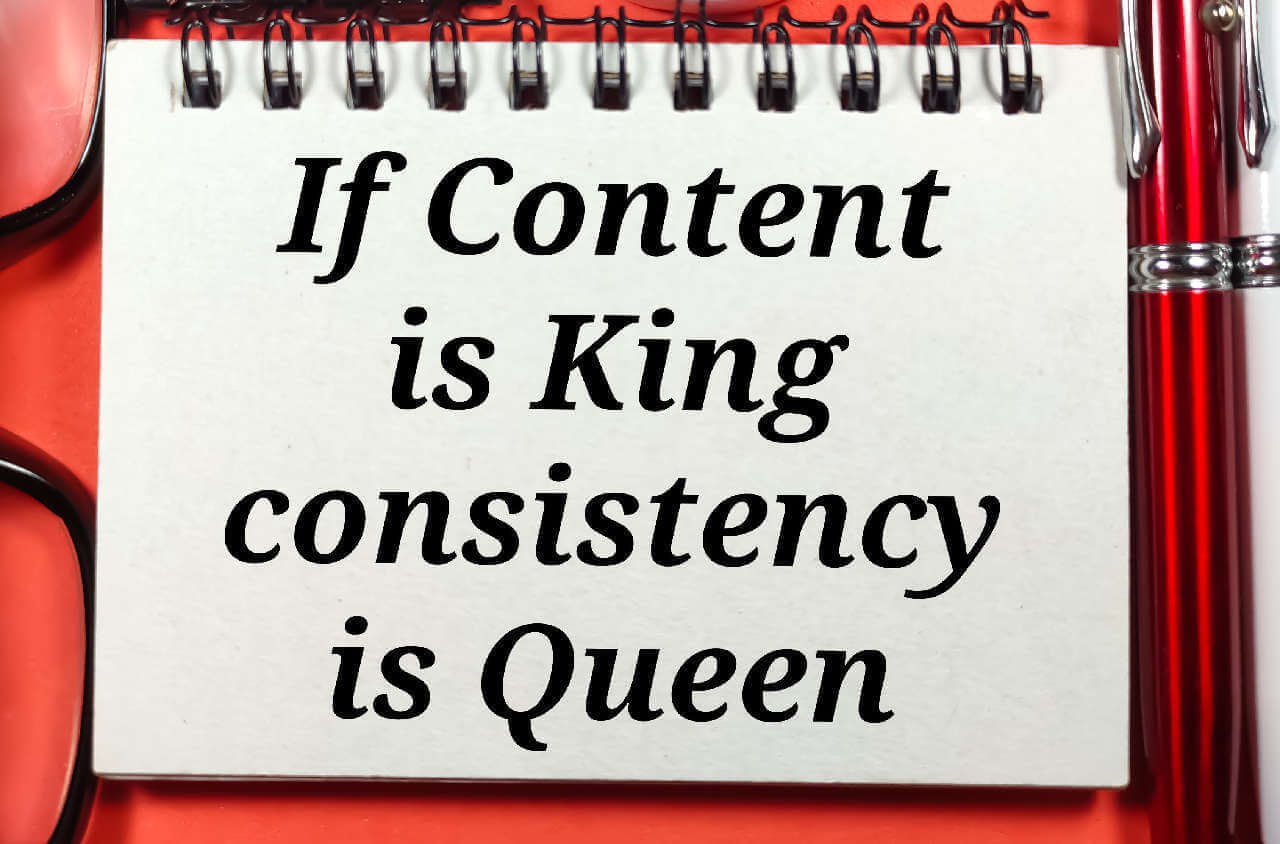
Marketers know that creating unique content is a proven way to get the attention of customers. Creating high-value material in an engaging and natural manner can drive organic traffic, increase sales, and improve brand image and perception. Many factors contribute to a brand’s success, but perhaps one of the most valuable is content consistency. From social media and blogging to responding to customer reviews and replying to emails, your content needs to maintain a consistent voice, tone, and style. However, maintaining a uniform voice and tone isn’t the only important aspect of content consistency. The amount of content and when you publish it is also integral to any savvy marketing strategy. Creating content doesn’t have to be a difficult or complicated process, but it does need to be consistent and valuable to your audience. In this article, we’ll cover how to create consistency in marketing so that you can reap the rewards of it in your business.
Why Is Consistency Important In Your Marketing Strategy?
Why Is Consistency Important In Your Marketing Strategy?
"So what if I don't post consistent content consistently? I still have content out there for my target audience." If you are asking this, then you don't know the perils of inconsistency in your marketing efforts. It can potentially destroy any of the efforts you have already made. Without consistency, you will become stagnate and be a mere speck in the ever-expanding sea of content. However, consistency in business will give you the leads you want, convert your leads to customers, and increase customer engagement and reviews.
Leads: Being consistent in the specific content you use for the position in the buyer's journey your audience is at is important to gain the leads you need for your business to grow. Educational content will help you capture the attention of the audience you are writing for, and you will, in return, be able to generate more leads by merely being consistent in using the same quality and quantity of content. You will then have created a pattern of trust from being consistent.
Customers: As you consistently provide quality content for your leads, they will find you trustworthy and begin converting into customers. Consistency in being educational, using the language they use, and meeting them where they are helps close leads into customers.
Engagement and Reviews: After they are customers, consistency is still important. It entices your customers to engage with you and leave you those coveted shiny reviews that can help the image of your business.
How to Create a Consistent Content Strategy
How to Create a Consistent Content Strategy
A content strategy outlines how you plan, create, and deliver your content. There's no one size fits all; one creator's content strategy will look completely different from the next. Even the one you build for yourself will change and morph over time as you grow. Building a content strategy might sound like work about work, but the benefits highly outweigh the costs. A content strategy will help you:
- Organize your content creation process.
- Schedule when and where you post content.
- Scope potential topics and unify your voice. Measure content success.
- Measure content success.
Here are the systems and processes you can follow so that you can maintain consistency in your content marketing.
Design Your Content Marketing Process
Design Your Content Marketing Process
There are a lot of different models and maps charting the content marketing process. For our purposes, we’ll break it down into the following five buckets:
- Content Planning and Strategy: This includes everything involved in developing an overarching plan and strategy for your content.
- Content Creation: This includes everything involved in creation processes and workflows.
- Content Publishing: This includes everything involved in establishing publishing schedules and cadences.
- Content Distribution and Promotion: This includes everything involved in promoting a piece of content.
- Content Measurement: This includes everything involved in analyzing performance and extracting insights to refine your content strategy in the future

Document Your Strategy
Document Your Strategy
Now the real work starts. You need to document your content distribution strategy. Content Marketing Institute found that just “37% of B2B marketers and 40% of B2C marketers have a written content marketing plan.” It’s surprising to see such low percentages, especially because documenting a process increases its success rates.
Here’s what needs to go in your strategy document:
Here’s what needs to go in your strategy document:
- Your ideal audience—define 2-4 ideal buyer personas and list their key demographics, such as age, gender, household size, hobbies, and income level.
- Your distribution platforms—Choose the social platforms, publications, websites, and forums that your personas frequent. Consider which ones make the most sense for your brand as a distribution channel.
- The type of content you distribute—what kind of content does your audience interact with, and what type of content can your brand produce in-house? Weigh your team’s capabilities and resources against the requirements for creating unique content that your audience will love.
- Your distribution schedule—determine when you will disseminate content and how often to publish/post.
- Your distribution process—specify what happens to each type of content that is created by establishing distribution procedures.
You can do a million different things to distribute your content. That makes it even more important to plan each step of the process.
Develop a Content Distribution Strategy
Develop a Content Distribution Strategy
Content distribution is any method used to disseminate content that is seen by an audience. Smart content distribution isn’t quick and easy. It takes time to choose your distribution methods and channels and then test to see which ones work best for your brand. There are three types of content distribution:
- Owned Content Distribution – This includes any properties owned by your brands, like your blog, social media, website, and email.
- Earned Content Distribution – This includes all third-party distribution of your content, such as press coverage, social shares, guest posts, reviews, and testimonials.
- Paid Content Distribution – This includes any method you pay for to distribute content and can comprise display ads, social media ads, publisher partnerships, PPC, and influencer promotions.
Leveraging a combination of all three tactics is often a successful approach to content distribution. For example, if you publish a 2,000-word blog post, you can distribute it to your social media channels, promote the post on Facebook, and republish it on a high-authority site.
Build Your Content Marketing Team
Build Your Content Marketing Team
We'll walk you through the key steps to creating your own content marketing team from scratch. So, whether you are expanding your existing company's marketing efforts or building an agency, you can avoid common pitfalls while scaling your results.

Decide between an in-house or distributed team.
Decide between an in-house or distributed team.
This is one of the essential aspects of creating your team. You need to decide from the start if remote work fits your business goals and management style. Plenty of companies love the flexibility that remote, distributed teams can offer. And contrary to popular belief, remote team members can be more productive, not less. However, there are obvious benefits to having a physical office. When teams work in-house, it can speed up the communication process. It can also build a sense of community that is sometimes lacking when you never meet your colleagues face-to-face.
Commit to a project management tool.
Commit to a project management tool.
We've all got more emails than we can handle these days. And if you're relying on your inbox to stay on top of your content marketing projects, you're in for a bumpy ride. There are project management tools for every team size, work style, and budget. Slack, Trello, Asana, and ClickUp are great options that come with free trials. Regardless of the route you go, look for software with the following features:
Assign Responsibility: Content marketing assets have a lot of moving pieces. You often need collaboration from multiple team members. Being able to assign tasks and hand off the next piece is crucial.
Calendars: As a manager, you have to step back and view your ongoing projects with a bird's eye view. Seeing start dates, due dates, and overlapping projects help you meet your company's — or your client's — content deadlines.
File-Sharing: Simple to-do lists work fine on an individual level. But at some point, you need to distribute photos, videos, or share documents among a number of key players.
Having these features at hand lets, you know who's responsible for what and when a project can move to the next team member. This way, nothing falls through the cracks.
Hire the right people.
Hire the right people.
Now you've laid out the structure of your content marketing strategy. You know what you're trying to achieve, the workflow you'll use, and whether you'll look locally or globally for talent.
But now you need to decide who to hire. This is the final step and a major stumbling block when building your content marketing team. So here's how to ensure you bring the right team members on board while weeding out the rest.
Hire Specialists: As they say, jacks-of-all-trades are often masters of none. Avoid the temptation to save on payroll by hiring one team member who claims to do it all. Quality will suffer. Developers should develop, writers should write, and designers should design.
Confirm Availability: Since you already set clear content goals, you'll know how much time commitment you need from various roles. For example, if you are running video campaigns primarily, then your video editor needs high availability. Whether you require 40 hours a quarter or 40 hours per week, confirm that potential hires have the bandwidth to contribute when called upon.
Once you've hired the right team with the criteria above, the final step of your building phase is complete. You're ready to execute your marketing campaigns with confidence.
Tips for Improving Consistency of Your Content Marketing
Tips for Improving Consistency of Your Content Marketing
Whether you publish blogs every day or once per week, it’s crucial for your organization to choose and adhere to a schedule. When your content quality, quantity, or schedule isn’t consistent, it can confuse your customers. Keeping with a regular strategy not only helps create a better customer experience but also helps build credibility, reputation, and brand trust. Consistency can also impact your bottom line. According to Techipedia, consistent brands are worth 20% more than those with inconsistencies in their messaging. Here are practical tips to help you stay consistent with your content:

Stay Consistent
Stay Consistent
In 2019, videos were estimated to comprise roughly 80% of all online consumer traffic. That means failing to maintain a video content marketing strategy is no longer an option for all brands and companies seeking to make a serious impact on potential leads. And while there are a number of excellent methods you might pursue to optimize your video’s SEO or build brand loyalty through video content marketing, one tried-and-true concept continues to make an impact on the field: Consistency.
The value of consistency extends beyond modern video content marketing. It harkens back to the oft-quoted “rule of seven,” a guiding principle from the Golden Age of advertising, which purports that the average prospective customer needs to notice something (like your brand) seven times before they take action. By extension, consistent posting elevates the rule of seven to the nth degree by keeping your company fresh and relevant in the eyes of potential leads.
Brands that post content consistently and maintain consistent voices throughout their content are valued at up to 20% more than their more haphazard peers. By posting consistently, your brand maintains its real estate in the hearts and minds of viewers around the world. You’re able to build a sense of anticipation for each new content piece, persistently drawing in unreliable viewers and generating an overall impression of brand stability.
Unfortunately, for some brands, consistent posting can feel like a whole lot more work than just putting up whatever content you want, whenever you want. But this doesn’t have to be the case. Figuring out (and maintaining) a metrically-valid consistent posting strategy is easier than ever, with just a little bit of research, planning, and delegation.
Numbers Matter
Numbers Matter
Before you launch your brand-new, hyper-consistent video content strategy, you need to hit the books and make some hard decisions about what that strategy even is. While that may sound like the most obvious first step in the world, only 37% of B2B organizations have a documented strategy for their content creation and distribution. That means that just by plotting out a strategy in advance, your brand or company is already pulling ahead of the majority of your less-organized peers.
Once you begin to document your strategy, the question of defining “consistency” comes into sharp focus. How often should you be posting video content to optimize the efficiency of each piece? Without first having a firm grasp of established statistics, you won’t be able to draw up a plan that works for your particular needs and capabilities.
Every distribution platform has a different set of parameters and metrics to keep in mind – trying a “one size fits all” approach will be less effective than tailoring your strategy to each individual opportunity. For some platforms, there is a relatively strict middle ground between too much and too little.
Facebook is a particularly stern example. At a minimum, brands should post to Facebook three times a week. But based on a brand’s following, posting too frequently can be almost as risky as not posting enough: Pages with under 10,000 fans can experience a 50% drop in engagement per post if they post more than once a day. Instagram and LinkedIn also both benefit from one solid post a day, while Twitter averages 15 posts a day for optimized success. Any more, and you risk overwhelming your target audience. Any less, and they are not as likely to add your content to their viewing routine.
After you figure out how many daily posts you need, it’s time to break down when you should post. That’s right—time of day matters almost as much as the frequency in terms of connecting with your ideal audience. Knowing all the best times by heart can feel impossible. Fortunately, Sprout Social has broken down a schedule of optimized posting times on various channels here.
Keep these numbers in mind as you calculate how much content you need to prepare in advance and where you intend to release it. Then, once you have your deliverables, you can figure out and document an ideal creation/distribution strategy. And don’t forget that consistency is more important than frequency. That means you need to decide on a schedule that works for you and then stick to it as closely as you can for as long as you can. It’s better to meet your goal to post twice a week consistently than to aim for ten posts a week and fluctuate wildly in execution.
Count the Days
Count the Days
Arguably the most important tool in your video content marketing kit is your editorial calendar. Creating a piece of content is challenging in the first place, true. So is crunching the numbers to decide where it best fits. But actually sticking to your plan is where many brands will fall apart. The mental capacity it takes to remember what videos to post on which platform and when is too much for many of even the most capable marketing pros.

Having a thoughtful editorial calendar is the perfect way to stay on schedule, develop longer-term strategies, and organize your team. When scheduling becomes a team effort, the shared accountability will echo the accountability that you have to your viewers. Try using one of these top-rated editorial calendar tools to intuitively assign tasks and make sure that your video content marketing stays on schedule.
However, the work doesn’t stop with each post. Once you begin to upload content more consistently, you need to keep track of if your specific days, times, and platforms are working as well as you planned. If a certain type of content is not generating engagement efficiently at a certain time or on a certain channel, you need to take steps to rectify the situation. Even posting consistently will not increase your overall brand engagement if you are consistently wrong. Think of it as using proper technique while weight-lifting – a heavier dumbbell will not help you develop more muscle if your form is flawed from the start.
Stay on Track
Stay on Track
Consistency is more than a content marketing buzzword. It is a promise to potential consumers that your brand knows what it is doing and that once you start, you see something through to completion. It is also one of the only confident ways to establish a presence in an increasingly crowded content space. So explore the possibilities of consistency today, and watch your video content engagement become a part of viewers’ lives.
Consistency Is Key In Your Marketing Strategy
Consistency Is Key In Your Marketing Strategy
Consistency in your business is far more important than you can imagine. Being consistent allows you to establish awareness, build trust and deliver your services efficiently and profitably. Without it, your business is more likely to fail. Universal Creative Solutions offers marketing and operations consulting to help you develop the systems in place so that you can maintain consistency in your content marketing. By regularly posting content, you open doors to more leads, customers, and the ability to scale your business. Schedule a consultation call and let us help you grow your business.

